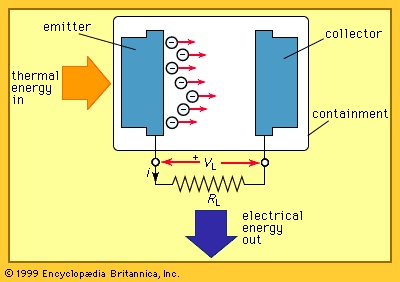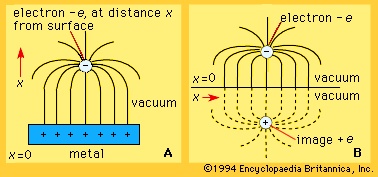thermionic power converter
electronics
Introduction
also called thermionic generator, thermionic power generator, or thermoelectric engine
any of a class of devices that convert heat directly into electricity using thermionic emission rather than first changing it to some other form of energy.
 A thermionic power converter has two electrodes (electrode). One of these is raised to a sufficiently high temperature to become a thermionic electron emitter, or “hot plate.” The other electrode, called a collector because it receives the emitted electrons, is operated at a significantly lower temperature. The space between the electrodes is sometimes a vacuum but is normally filled with a vapour or gas at low pressure. The thermal energy may be supplied by chemical, solar, or nuclear sources. Thermionic converters are solid-state devices (solid-state device) with no moving parts. They can be designed for high reliability and long service life. Thus, thermionic converters have been used in many spacecraft.
A thermionic power converter has two electrodes (electrode). One of these is raised to a sufficiently high temperature to become a thermionic electron emitter, or “hot plate.” The other electrode, called a collector because it receives the emitted electrons, is operated at a significantly lower temperature. The space between the electrodes is sometimes a vacuum but is normally filled with a vapour or gas at low pressure. The thermal energy may be supplied by chemical, solar, or nuclear sources. Thermionic converters are solid-state devices (solid-state device) with no moving parts. They can be designed for high reliability and long service life. Thus, thermionic converters have been used in many spacecraft.Emission of electrons from a hot plate is analogous to the liberation of steam particles when water is heated. These emitted electrons flow toward the collector, and the circuit can be completed by interconnecting the two electrodes by an external load. Part of the thermal energy that is supplied to liberate the electrons is converted directly into electrical energy, while some of the thermal energy heats the collector and must be removed.
Development of thermionic devices
As early as the mid-18th century, Charles François de Cisternay Du Fay, a French chemist, noted that electricity may be conducted in the gaseous matter—that is to say, plasma—adjacent to a red-hot body. In 1853 the French physicist Alexandre-Edmond Becquerel reported that only a few volts were required to drive electric current through the air between high-temperature platinum electrodes. From 1882 to 1889, Julius Elster and Hans Geitel of Germany developed a sealed device containing two electrodes, one of which could be heated while the other one was cooled. They discovered that, at fairly low temperatures, electric current flows with little resistance if the hot electrode is positively charged. At moderately higher temperatures, current flows readily in either direction. At even higher temperatures, however, electric charges from the negative electrode flow with the greatest ease.
In the 1880s the American inventor Thomas Edison (Edison, Thomas Alva) applied for a patent pertaining to thermionic emission in a vacuum. In his patent request, he explained that a current passes from a heated filament of an incandescent electric lamp to a conductor in the same glass globe. Though Edison was the first to disclose this phenomenon, which later came to be known as the Edison effect, he made no attempt to exploit it; his interest in perfecting the electric light system took precedence.
In 1899 the English physicist J.J. Thomson (Thomson, Sir J.J.) defined the nature of the negative charge carriers. He discovered that their ratio of charge to mass corresponded to the value he found for electrons, giving rise to an understanding of the fundamentals of thermionic emission. In 1915 W. Schlichter proposed that the phenomenon be used for generating electricity.
By the early 1930s the American chemist Irving Langmuir (Langmuir, Irving) had developed sufficient understanding of thermionic emission to build basic devices, but little progress was made until 1956. That year another American scientist, George N. Hatsopoulos, described in detail two kinds of thermionic devices. His work led to rapid advances in thermionic power conversion.
Because thermionic converters are tolerant of high acceleration, have no moving parts, and exhibit a relatively large power-to-weight ratio, they are well suited for some applications in spacecraft. Development work has focused on systems to provide electric power from a nuclear reactor on board a spacecraft. They can provide efficiency in the range of 12 to 15 percent at temperatures of 900 to 1,500 K (about 600 to 1,200 °C, or 1,200 to 2,200 °F). Since these converters function best at high temperatures, they may eventually be developed for use as topping devices in conventional fossil fuel power plants. Their currently available efficiencies make them suitable power sources for terrestrial application in certain remote or hostile environments.
Principles of thermionic emission
A thermionic power converter can be viewed as an electronic diode that converts heat to electrical energy via thermionic emission. It can also be regarded in terms of thermodynamics as a heat engine that utilizes an electron-rich gas as its working fluid.
A major problem in developing practical thermionic power converters has been the limit imposed on the maximum current density because of the space-charge (space charge) effect. As electrons are emitted between the electrodes, their negative charges repel one another and disrupt the current. Two solutions to this problem have been pursued. One involves reducing the spacing between the electrodes to the order of micrometres, while the other entails the introduction of positive ions into the cloud of negatively charged electrons in front of the emitter. The latter method has proved to be the most feasible from many standpoints, especially manufacturing. It has resulted in the development of both cesium and auxiliary discharge thermionic power converters.
 Emission of electrons is fundamental to thermionic power conversion. The energy required to remove an electron from the surface of an emitter is known as the electronic work function (ϕ). Its value is characteristic of the emitter material and is typically one to five electron volts (electron volt). Some electrons within the emitter have an energy greater than the work function and can escape. The proportion depends on the temperature. The rate at which electron current in amperes (ampere) per square metre is emitted from the surface of the emitter is given by the Richardson–Dushman equation; i.e.,
Emission of electrons is fundamental to thermionic power conversion. The energy required to remove an electron from the surface of an emitter is known as the electronic work function (ϕ). Its value is characteristic of the emitter material and is typically one to five electron volts (electron volt). Some electrons within the emitter have an energy greater than the work function and can escape. The proportion depends on the temperature. The rate at which electron current in amperes (ampere) per square metre is emitted from the surface of the emitter is given by the Richardson–Dushman equation; i.e.,
where T is the absolute temperature in kelvins (kelvin) of the emitter, e is the electronic charge in coulombs (coulomb), and k is Boltzmann's gas constant (Boltzmann constant) in joules (joule) per kelvin. The parameter R is also characteristic of the emitter material. This expression for emission current is named for Owen Willans Richardson (Richardson, Sir Owen Willans) and Saul Dushman (Dushman, Saul), who did pioneering work on the phenomenon. Note that the rate of emission increases rapidly with emitter temperature and decreases exponentially with the work function. It is therefore desirable to choose an emitter material that has a small work function and that operates reliably at high temperatures.
Electrons that escape the emitter surface have gained energy equal to the work function, plus some excess kinetic energy. Upon striking the collector, a part of the energy is available to force current to flow through the external load, thereby giving the desired conversion from thermal to electrical energy. Part of this energy is converted to heat that must be removed to maintain the collector at a suitably low temperature. The collector material should have a small work function.
Major types of thermionic converters
Vacuum converters
The available power and the efficiency of a thermionic converter can be severely limited by buildup of space charge between the electrodes. The vacuum type of thermionic converter uses a very small gap between its emitter and collector electrodes—typically 0.025 to 0.038 mm (0.001 to 0.0015 inch)—in order to minimize the effects of this electronic space charge. At a temperature of 1,100 K (about 800 °C, or 1,500 °F) the electric power converted is 0.1 to 1 watt per square centimetre of emitter surface. Converters with such small spacings are difficult to manufacture, though. As a result, the vacuum converter has had only limited practical application.
Gas-filled or plasma converters
These devices are designed so that positively charged ions (ion) are continuously generated and mixed with negatively charged electrons in the space between the emitter and the collector to provide a plasma with a relatively neutral space charge. Because of this, a liberated electron encounters little electrostatic resistance force in passing from the emitter to the collector. Alkali metals (alkali metal) are used to produce a readily ionizable vapour. cesium is used in the most efficient converters because of its low ionization potential (ionization energy) (3.89 electron volts). potassium, rubidium, and various other elements may also be used. The vapour pressure is normally on the order of 100 pascals. Contact ionization occurs when the ionization potential is less than the work function of the emitter material. tungsten is a suitable emitter material because of its ability to operate at relatively high temperatures.
Auxiliary discharge converters
In an auxiliary discharge converter, an inert gas is used between the electrodes (e.g., neon, argon, or xenon). Positive ions are produced by applying voltage to a third electrode. The principal advantage of the auxiliary discharge converter—so called because of its spark-plug-type configuration—is that it can operate at a relatively low temperature (e.g., 1,500 K, about 1,200 °C or 2,200 °F), allowing a range of conventional fossil fuels (fossil fuel) to be used as the heat source. Some experimental systems have been built and tested.
Additional Reading
Stanley W. Angrist, Direct Energy Conversion, 4th ed. (1982), provides a historical introduction and overview. Reiner Decher, Direct Energy Conversion: Fundamentals of Electric Power Production (1997), is a good technical review. Francis F. Huang, Engineering Thermodynamics: Fundamentals and Applications, 2nd ed. (1988), is a general text on thermodynamics. G.N. Hatsopoulos and E.P. Gyftopoulos, Thermionic Energy Conversion, 2 vol. (1973–79), contains a useful discussion of thermionic converters.
- Colossus
- colossus
- Colossus of Rhodes
- colostomy
- colotomic structure
- colour
- colour blindness
- colour centre
- Coloured
- colour-field painting
- colour index
- colour music
- colour printing
- colour vision
- colour–magnitude diagram
- Colter, John
- Colton, Gardner Quincy
- Coltrane, John
- Colt, Samuel
- colubrid
- Coluccio Salutati
- Columban, Saint
- columbarium
- Columba, Saint
- Columbia